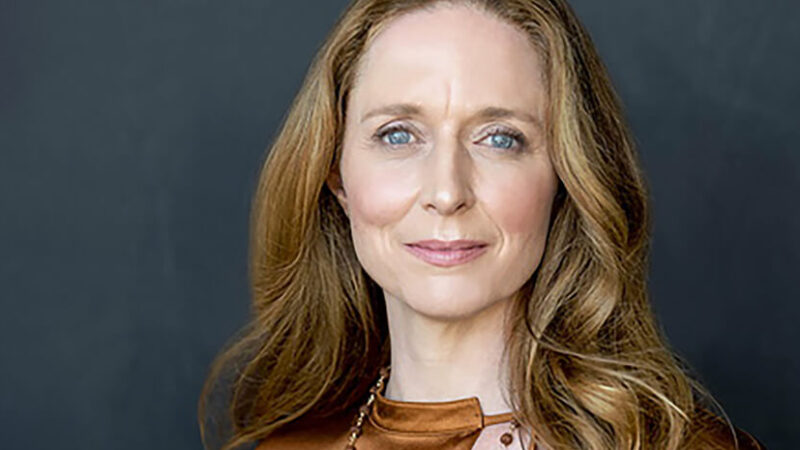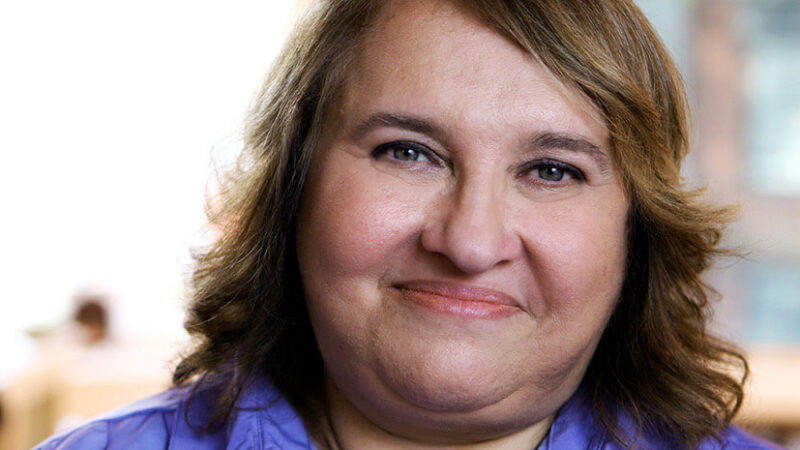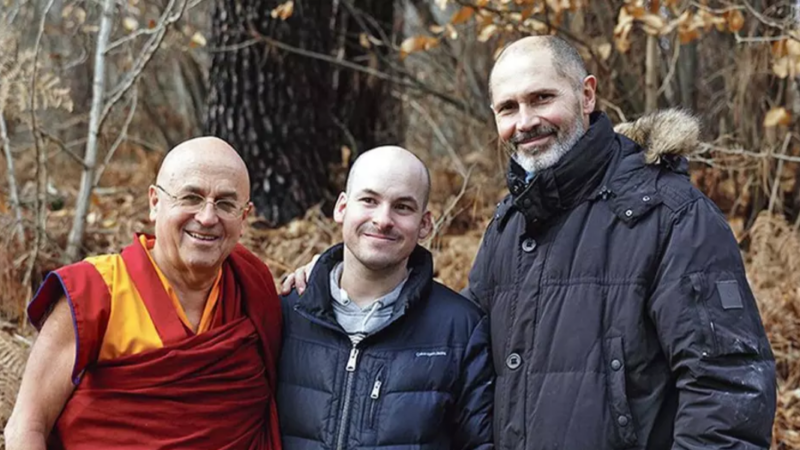-
E117: The Real Work: Letting Go from Within
Michael Singer — October 2, 2025
True spirituality isn’t about mystical experiences or lofty ideals—it’s about honestly facing...
-
Once More: Reflections on Reincarnation and the Gap Between Lives
Tami Simon — September 26, 2025
In this special reflection episode of Insights at the Edge host Tami Simon looks back on her...
-
Honey Tasting Meditation: Build Your Relationship with Sweetness
There is a saying that goes “hurt people hurt people.” I believe this to be true. We have been...
Written by:
Amy Burtaine, Michelle Cassandra Johnson
-
Many Voices, One Journey
The Sounds True Blog
Insights, reflections, and practices from Sounds True teachers, authors, staff, and more. Have a look—to find some inspiration and wisdom for uplifting your day.
Standing Together, and Stepping Up
Written By:
Tami Simon -
The Michael Singer Podcast
Your Highest Intention: Self-Realization
Michael Singer discusses intention—"perhaps the deepest thing we can talk about"—and the path to self-realization.
This Week:
E116: Doing the Best You Can: The Path to Liberation -
Many Voices, One Journey
The Sounds True Blog
Insights, reflections, and practices from Sounds True teachers, authors, staff, and more. Have a look—to find some inspiration and wisdom for uplifting your day.
Take Your Inner Child on Playdates
Written By:
Megan Sherer
600 Podcasts and Counting...
Subscribe to Insights at the Edge to hear all of Tami's interviews (transcripts available, too!), featuring Eckhart Tolle, Caroline Myss, Tara Brach, Jack Kornfield, Adyashanti, and many more.
Most Recent
The Sacred Art Of Taking A Bath

When I tell my students that one of the most magical things they can do is take a bath, I rarely have to say anything more, for we intuitively know that the time we take to shower and bathe is time touched by wild magic, and the space in which we do so is space imbued with the scent of the sacred.
Make Your Bath Sacred
Consider your own bathing rituals right here and right now. Begin with the fundamental question, “What needs to be washed away, removed, released?” And then, “What kind of bathing appeals to you the most?” A brisk shower or a slow bath? If you use products like bubbles, soap, bath salts, or body scrubs, why did you select them? Do you love to bathe in the privacy of your own home, or do you feel most connected to your remembered magic when you immerse yourself into a wildly running river, the cresting waves of a great ocean, or the green depths of a limestone spring? What elements need to be in place to change your bathing experience from one that is merely practical and about physically cleaning yourself to one that is also extraordinary and capable of washing away deeper marks and struggles?
Where do you feel dry?
Just as the land where we live contains water, our soul soil also holds swift rivers, vast oceans, and deep springs. These interior waters are the places understood to hold the human capacity for deep feeling and emotion, creativity, love and compassion, vitality and nourishment. And just like bodies of water in the surrounding world, our interior waters can be dammed up, walled off, covered over, and blocked in a variety of ways. These waters can also be polluted. Sometimes this is done by others or is a result of the toxic aspects of the culture at large, and sometimes we do it to ourselves without realizing it. Having set up house in multiple arid lands, I can tell you from firsthand experience that the presence or the absence water in our surrounding world presses us to ask hard questions about our internal waters. Consider where your life feels dry, uninspired, lacking creativity, fecundity, and fertility? Where are the places that have become too tough and hard and not nearly tender enough? Where has your soul soil been in drought for year upon year, so that all you can find there is dry dust and cracks in the ground? Where is the spark of life lacking or completely absent?
Where do you feel in the flow?
After considering what makes you feel dried up and devitalized, consider the opposite. What calls up your life and creativity? What makes you feel like your inner landscape is well irrigated and flowing with wide rivers or caressed by ocean waves? What are the ways that you best clean up the hurt places in your life? What are the medicines that help you heal most readily and completely? Our work here calls us to an awareness of the places that feel broken, the parts of life and the stories, beliefs, and habits that devitalize us from the inside out. Working with water in an intentional manner can also highlight these places, for we become acutely aware of where precisely there is lack. It is natural to feel that there is not enough water in the whole world to slake the deepest soul thirst and soothe the most parched places of our hearts. It is true: there is not enough water in the world to quench that thirst. But there is enough water in each of us. When you live in a desert, as I have for most of my life, you come to know this as fact. There is good water, strong and flowing, usually many miles beneath the surface, and when the thunderclouds come in and the wind begins to blow just so, the sheer rocks themselves begin to usher forth rivers and streams, and the well that springs up from the deepest self carries on its waves life-bestowing and life-affirming blessings.
Don’t have time for a full sacred bath every day? Try these stepping stones instead!
Make moon water. Fill up a clear glass jar with water and leave the top of it open. Set it outside under a full moon. Drink it down the next morning and note the texture, taste, and feel of the water as you do. Notice too how your body feels after drinking it.
Create a sacred spray. Get a spray bottle, fill it with water, add a few drops of your favorite essential oils, and use this quick version of sacred water to spritz yourself and your home, as you like.
Give yourself a footbath. Fill a basin with warm water, and add a teaspoon of baking soda, some lemon and lime slices, and any essential oils you like. After soaking your feet, pick out an oil or lotion to anoint your feet. Cleansing and anointing the feet is an ancient practice that honors one of the most sensitive (and taken for granted) parts of our bodies.
This is an excerpt from Making Magic: Weaving Together the Everyday and the Extraordinary by Briana Henderson Saussy.
Download a free Making Magic journal here.

Briana Saussy is a teacher, spiritual counselor, and founder of the Sacred Arts Academy, where she teaches tarot, ceremony, alchemy, and other sacred arts for everyday life. She lives in San Antonio, Texas. For more, visit brianasaussy.com.
Buy your copy of Making Magic at your favorite bookseller!
Sounds True | Amazon | Barnes & Noble | Indiebound


What Is Ahimsa? Yoga Meets Plant-Based Living (+ recip...

The time is always right to do what is right.
MARTIN LUTHER KING JR.
What is Ahimsa?
Patanjali’s Eight Limbs of Yoga consist of two main components: yamas (things we must abstain from in order to lead a spiritual and ethical yogic life) and niyamas (spiritual observances). The very first of the yamas is ahimsa, or non-harm. This principle lies at the very heart of yoga and should be applied to everything—how we treat ourselves, how we treat others, and how we treat the world around us.
Of course, it’s logistically impossible to make it through life without causing any harm whatsoever. We live in a world in which we cannot escape creating some kind of pain. This world has been set up as being “perfectly imperfect.” If we walk across a park, we will step on ants. If we wipe sweat off our forehead, we will kill millions of bacteria. So how do we create the least amount of harm while we are here on this earth? If we cannot escape killing and harming completely, then how do we minimize our footprint?
Practicing Ahimsa through food
With this in mind, we do the best we can. The truth of the matter is that, even without consciously abiding by the Eight Limbs of Yoga, most of us innately attempt to live our lives in a way that doesn’t inflict harm on others. However, one way in which even the most gentle and aware among us do cause harm is by eating in an unconscious manner. We don’t stop to consider where our food is coming from or how it is making its way to our plate. For most of us, eating offers a prime avenue for becoming more aware of the earth and living beings around us and of alleviating some of the harm we are causing, often without even really being conscious of it!
One of the arguments we often hear about practicing ahimsa by eating a plant-based diet is, “Well, plants are living things, too, and you’re harming them!” This is true. Every living being on this planet—whether it be a human or an animal or a tree—has what yogis call a jiva-atma, or a soul, residing within it.
Carrot vs. Cow
The idea of ahimsa is to cause the least amount of harm as possible. We like to explain it this way: let’s think about the difference between eating a carrot and a cow, bearing in mind that, in each case, we are causing harm. When we eat a carrot, we harm the carrot. But to make a cow eligible for slaughter, she must weigh at least a thousand pounds. In order for cows to gain weight, they need to eat and metabolize food, just like humans do. Specifically, for a cow to gain one pound, she has to eat between 16 and 20 pounds of grain. Let’s stop and think about this for a moment. This means that before we can even think about eating a cow, an enormous number of plants have to be killed in order to feed her. Imagine how many people you could feed with that amount of grain, compared to the one pound of beef protein that it produces.
The harm doesn’t stop there. It takes 2,500 gallons of water for a cow to produce one pound of beef. In other words, it takes 2.5 million gallons of water to get a single cow to one thousand pounds. And beyond that, animal agriculture is also one of the leading causes of air and water pollution and deforestation. The amount of harm caused by these two environmental hazards is unquantifiable.
Eat less meat, feed more people
Now think about the fact that one-seventh of the world’s population today is starving. One of the primary reasons is that most of the world’s grains and produce are used to feed animals for slaughter. These animals add up to a much smaller amount of food than grains and produce—it is food designated only for the people who can afford it. Perhaps you’ve heard the saying, “If everyone wanted to eat a meat-based diet, we would need two planet earths”?
But if everyone ate a plant-based diet, we could feed two planet earths. Aside from just harming the animals who go to slaughter, to produce them we are using up food and water resources that leave other humans wanting, and we are polluting the earth. That’s a lot of harm for a single meal. And we’re willing to bet that most of the people who pay into that vicious cycle have no desire to create any harm.
Ahimsa & the vegan diet
When we eat a vegan diet, we can avoid all of this harm—and without sacrificing any of the taste. We can feel good about our choices for ourselves and for the world around us. We are literally playing a role in decreasing the suffering of an entire planet, including the human beings, animals, plants, and the very earth we walk upon. Think of what an impact you can have by making different, mindful decisions about what you fuel your body with at least three times a day, every day of your life!
Eating this way has other advantages. When we eat vibrant whole foods in place of meat and dairy, our bodies start humming along in a more natural rhythm, making us feel both physically better and more spiritually connected. Eating a whole-food, plant-based diet nourishes our body in a unique and noticeable way because the food is of a higher quality and nutrient content than processed foods. The plethora of vitamins, minerals, and essential nutrients fuel our physical constitution at the highest level. In the same way as a car will run more smoothly for a longer period of time when it is provided with high-grade fuel, so too will our bodies. And just as our bodies are better nourished with the vitamins and minerals plants provide, so too are our brains, which makes us quicker and more alert. Spiritually, we become more attuned to the life and resources around us, and we experience a greater sense of gratitude and interconnection.
Victoria is a prime example of this. As daunting as the idea of giving up meat and meat-based products initially was to her, today there’s no looking back. Not only does she feel stronger and more physically energized, but her entire life has shifted. She feels more aligned with and attuned to the world around her. She no longer searches for happiness in material things but, rather, turns to spiritual matters and meditation for fulfillment.
Recipe: Vegan Key Lime Cheesecake
MAKES ONE 9-INCH PIE
Key lime pie is one of the most popular dishes in America. It is sweet, tart, and rich. That flavor combination translates perfectly to cheesecakes. We have created a Key Lime Cheesecake that is so decadent and fulfilling, it’ll win over any pie or cheesecake lover in a heartbeat. Plus it is packed with superfoods and other healthy ingredients. The avocado is the star in this recipe. It gives the cheesecake a beautiful green color and adds a creaminess that is amazing in flavor and depth. This delicious dessert will satisfy your body as well a your sweet tooth.

FOR THE CRUST:
INGREDIENTS
- 1 cup pecans
- 1 cup walnuts
- 1 tsp. coconut oil
- ½ cup pitted dates
(preferably Medjool)
- ⅛ tsp. Himalayan pink salt
- ½ tsp. vanilla extract
- Place the pecans and walnuts in a food processor and blend until the nut pieces are small and granular, about the size of rice grains.
- Add the coconut oil, dates, salt, and vanilla extract to the food processor. Blitz until the mixture forms a crust-like consistency.
- Spoon the crust into a 9-inch cheesecake pan. Press the mixture into the base of the pan evenly with your fingers. Set the pan in the freezer while you work on the filling.
FOR THE FILLING:
INGREDIENTS
- 1 cup raw cashews, soaked for at least 2 hours
- ½ cup chilled coconut milk
- ½ cup coconut oil
- ½ cup maple syrup
- ¼ cup fresh-squeezed lime juice
- ½ tsp. vanilla extract
- ½ cup avocado chunks
- Pinch of Himalayan pink salt
- Place all of the ingredients except the avocado into a high-powered blender and blitz on high for 45 seconds, or until creamy and smooth.
- Separate ¼ cup of the filling mixture and set aside. Add the avocado chunks to the rest of the mixture in the blender and blitz again for 45 seconds, or until creamy and smooth.
- Pour the avocado mixture into the cheesecake pan and spread evenly. Tap the pan lightly on a cutting board to get out any air bubbles.
- Drizzle the reserved ¼ cup white mixture all over the top of the green cheesecake, as if you are trying to draw lines with it. With a toothpick tip, carefully swirl the lines to create the classic cheesecake look.
- Place in the freezer for at least 2 hours to set. About 15 minutes before serving, remove from the freezer. To get perfectly clean slices, run your knife under hot water before cutting each piece.
- Store in an airtight container in the refrigerator for up to 1 week or in the freezer for about 3 weeks.
This is an excerpt and recipe from The Yoga Plate: Bring Your Practice into the Kitchen with 108 Simple & Nourishing Vegan Recipes by Tamal Dodge and Victoria Dodge.

Tamal Dodge is a renowned yoga teacher, trainer, and cofounder of LA’s premiere yoga studio, Yoga Salt, with its newest location in North Carolina. He’s been featured in the New York Times, the LA Times, Time magazine, the Chicago Tribune, Self, Better Homes & Gardens, Yogi Times, mindbodygreen, and more. He teaches yoga around the world and stars in several bestselling yoga DVDs that are sold worldwide. yogasalt.com
Victoria Dodge is a cofounder of Yoga Salt, professional photographer, and cooking expert who has worked with companies such as Lululemon, Forbes, and Apple, as well as celebrity clients, models, and Hollywood figures like Shaquille O’Neal, James Cameron, and Sterling K. Brown. The Dodges live in North Carolina with their two children. Learn more at theyogaplate.com.
Buy your copy of The Yoga Plate at your favorite bookseller!
Sounds True | Amazon | Barnes & Noble | IndieBound


In 2020, Find Your Life’s Purpose (the japanese ...

Why do you get up every morning? What motivates you to get out of bed every day? In Japan there is a term to describe our reason for living or being: ikigai.
We all have an ikigai, even if we don’t know it.
In fact, the search for an ikigai is what will bring large doses of satisfaction and self-fulfillment because when you connect with your ikigai, your life will acquire a meaning. Often we live a life that is full of appearances, possessions that appear to speak for who we are, jobs that provide much prestige but that we don’t enjoy, inherited stereotypes, scraps of other lives, and only superficial meaning. But that life full of appearances has a tendency to crumble and fall apart, and, when it does, it’s usually in the form of a crisis. For some people, the crisis that tends to happen in adult life is an opportunity to ask ourselves what our ikigai is and what the meaning of our life is. However, when you are suffering, it’s not the best time to find a meaning for your life, because from a place of lacking, everything is harder.
Look for Your Ikigai
We have already established that at the very least you already have one ikigai, a reason to pick up your pieces. But I encourage you to think about what other ikigais you can find. Analyze the meaning of your life up until now and evaluate whether you need to redefine it.
Sometimes, because we have good intentions, we mistakenly believe that our lives consist only of our children, partners, work, parents, or a long list of other things, but in reality, you must never allow all your life’s responsibilities to revolve around a single meaning or a single motivation.
I have many ikigais that I carry with me every day! I get up for myself and for everything I enjoy doing. I get up for my wife and for my daughter, for my clients; to go for a stroll, to go for a bike ride, or to get lost skiing in the mountains; to use my talent to remove psychology from the confines of the lecture theater, to learn and teach, travel, smile, and enjoy a kiss and a hug. Each morning I get up for the bear hug I will give my daughter, to feel the sun on my skin, to get drenched in the rain, and to curl up with a good book. I could fill pages and pages with my ikigais, though that wouldn’t make as interesting a book, now would it?
An Exercise in Ikigai
To begin this exercise, ask yourself about the meaning behind what you are doing, where you are living, your work, your partner, your lifestyle, and your vacations. I encourage you to go over each and every one of the aspects of your life and to ask yourself whether they contribute to your happiness.
Start questioning the meaning of what you are about to do in each moment of your day. Even the mundane things! It may sound silly, but there is ikigai there!
What meaning is there in… Drinking a cup of coffee? Attending a specific conference? Helping a neighbor? In getting angry? In walking your dog? In writing a book?
Moving forward, continue to ask yourself about the meaning of what you are about to do in any moment, and there you will start to discover your own ikigais.
Learn more about the powerful practice of healing trauma and finding purpose in Kintsugi: The Japanese Art of Embracing the Imperfect and Loving Your Flaws by Tomás Navarro.

Tomás Navarro is a psychologist who loves people and what they feel, think, and do. He is the founder of a consultancy practice and center for emotional well-being. He currently splits his time between technical writing, training, consultancy, conferences and advisory processes, and personal and professional coaching. He lives in Gerona and Barcelona, Spain.
Read Kintsugi today!
Sounds True | Amazon | Barnes&Noble | IndieBound


Customer Favorites
Caverly Morgan: The Heart of Who We Are
When Caverly Morgan reentered society after eight years as a Zen monk, she was confronted with a question many of us are asking these days: Considering the enormity of the problems before us, how can one individual’s spiritual practice make a tangible difference in our world?
In this podcast, Tami Simon speaks with Caverly about her new book, The Heart of Who We Are, and the connection between self-realization and collective transformation. Tune in as they explore these topics and more: the difference between the absolute and the relative; introducing teens to inquiry practice; self-improvement vs. self-realization; the core experience of who we are in our depths; the power of community; meeting our deepest needs; “changing costumes within the dance of suffering”; connecting with others “essence to essence”; broadening public access to contemplative practices; escaping the trap of perfectionism; letting go of our conditioning, individually and collectively; egoic behaviors versus “acts of being.”
This episode first aired live and on video on Sounds True One. To watch Insights at the Edge episodes live and on video, and to access additional bonus Q&A, please visit join.soundstrue.com to learn more.
Giving Your Heart Over to Real Change
Sharon Salzberg, a student of Buddhism since 1971, has been leading meditation retreats worldwide since 1974. Influenced by her more than 25 years of study with Burmese, Indian, and Tibetan teachers, she teaches intensive awareness practice (vipassana or insight meditation) and the profound cultivation of lovingkindness and compassion (the Brahma Viharas). She is a cofounder of the Insight Meditation Society and the Barre Center for Buddhist Studies, both in Massachusetts. She is the author of books including The Kindness Handbook, Lovingkindness, A Heart as Wide as the World, and, most recently, Real Change. She has also authored several Sounds True audio programs including Insight Meditation (with Joseph Goldstein), Room to Breathe, and Lovingkindness Meditation.
In this podcast, Sharon Salzberg joins Sounds True’s founder, Tami Simon, to discuss her recent book, Real Change: Mindfulness to Heal Ourselves and the World—and how you can begin to bring the core of your being into your work, your community, and your life. Sharon and Tami also discuss how contemplative practices can open the heart, agency and reclaiming your power to effect change, the empowering symbol of the Statue of Liberty, transforming anger into courage, determining the next step you can take when you’re uncertain, patience, faith as the act of giving over your heart, generosity and how you end up with more through giving, moving from grief to resilience, suffering and the First Noble Truth, the role of joy on the path, living by the truth of interconnection, caring to know as the first step in making a difference, and a sneak preview of Sharon’s forthcoming book, Real Life.
Meet a Coauthor of . . . Freedom for All of Us
The Author
Matthieu Ricard is a Buddhist monk, humanitarian, and one of three authors of Freedom for All of Us: A Monk, a Philosopher, and a Psychiatrist on Finding Inner Peace, available in November, 2020. He is also the author of several other books, including The Monk and the Philosopher, Happiness, and Altruism. He is a major participant in research collaboration between cognitive scientists and Buddhist practitioners. Ricard is a noted translator and photographer, and has founded humanitarian projects in India, Tibet, and Nepal. For more information, visit karuna-shechen.org.
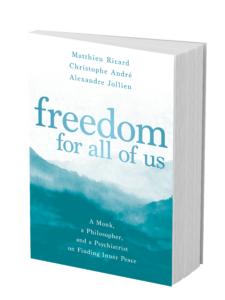
The Book
With their acclaimed book In Search of Wisdom, three gifted friends—a monk, a philosopher, and a psychiatrist—shed light on our universal quest for meaning, purpose, and understanding. Now, in this new in-depth offering, they invite us to tend to the garden of our true nature: freedom.
Filled with unexpected insights and specific strategies, Freedom for All of Us presents an inspiring guide for breaking free of the unconscious walls that confine us.
Send us a photo of your sacred space.
[Pictured here is the] Shechen Monastery in Nepal, where I live a good part of the year:
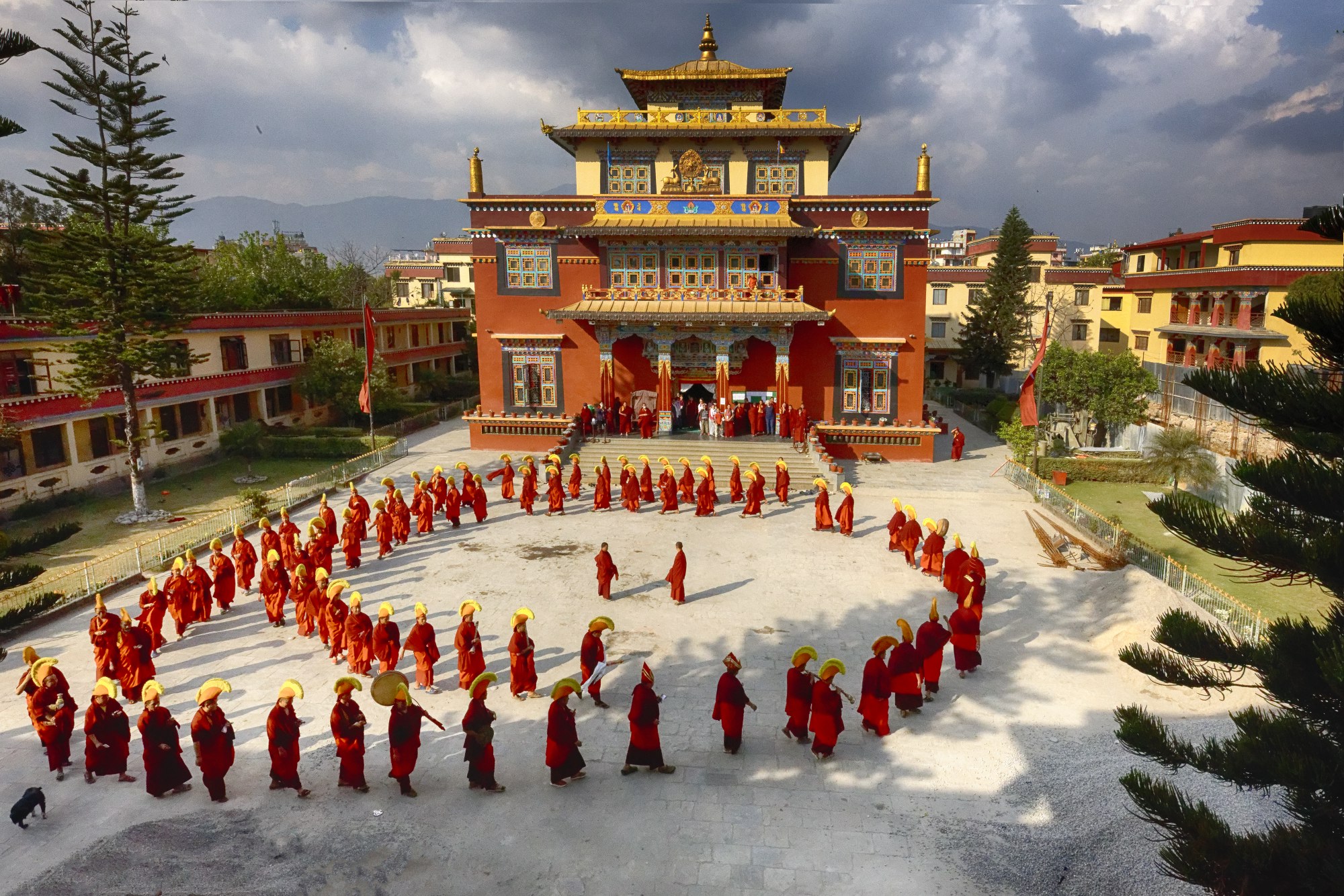
[And] the views from my hermitage in Nepal:

‘

If you could invite any three transformational leaders or spiritual teachers (throughout time) to dinner, who would they be and why?
I do not have dinner and he does not either, but if I had to choose to spend an hour quietly with someone alive today, it would be His Holiness the Dalai Lama. [He is] someone of boundless compassion and wisdom, who treats every sentient being—from the person who cleans the floor at the hotel when he travels, to a head of state—with the same kindness, respect, and attention.
As for [two people] who [are no longer] in this world, I would give everything to spend another hour in the presence of my two main spiritual teachers: Kangyur Rinpoche and Dilgo Khyentse Rinpoche, who inspire every instant of my life.
Has your book taken on a new meaning in the world’s current circumstances? Is there anything you would have included in your book if you were writing it now?
Many people have indeed faced great hardship; being sick, left alone, and having lost a dear one. But for those who simply had to be with themselves and a few kin, I was quite surprised to see how difficult they found [it] to just be with their own minds for extended periods of time. It seemed that it was such a new situation and they had few tools to deal with it.
As a contemplative, I value tremendously [the] time spent alone in my hermitage in the Himalaya[s], cultivating fundamental human qualities that allow me to slowly become a better human being. I believe that among those qualities, inner freedom and compassion are two key factors and that, therefore, our dialogue [in Freedom for All of Us] is quite timely. Most of the subjects that we reflect upon seem very relevant [during] these troubled times and I hope that they will be useful!

Learn More
Sounds True | Amazon | Barnes & Noble | Bookshop | IndieBound


